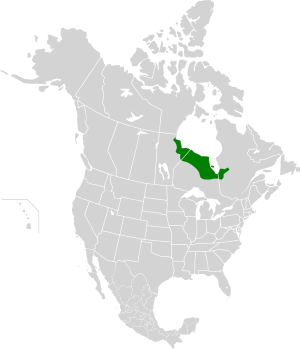Hudson Bay Lowlands facts for kids
The Hudson Bay Lowlands is a huge wetland area in Canada. It sits between the Canadian Shield (a large rocky region) and the southern coasts of Hudson Bay and James Bay. Most of this area is in Ontario, but parts also reach into Manitoba and Quebec.
Many wide, slow-moving rivers flow through the Lowlands towards Hudson Bay. Some of these rivers include the Churchill, Nelson, and Hayes in Manitoba. In Ontario, you'll find the Severn, Fawn, Winisk, Asheweig, Ekwan, Attawapiskat, and Albany rivers. Quebec has the Harricana, Rupert, and Eastmain.
This region is the largest wetland in Canada and one of the biggest in the entire world! It was covered by ice during the last Ice Age. Over the past 10,000 years, special spongy ground called peat has built up here.

Contents
Exploring the Hudson Bay Lowlands
The local Ojibwa and Cree people likely knew about this region. However, they did not settle here in large numbers. This was because the land was often wet and difficult to live on.
When Europeans arrived, the Hudson's Bay Company set up trading posts. Places like Rankin Inlet were important trading spots. Some of these posts are still small communities today. But they never grew into big towns because of the challenging climate and living conditions.
Even today, some parts of the Lowlands have not been fully explored. There are a few small First Nations communities along the southern shore of Hudson Bay. These include Moose Factory, Moosonee, Attawapiskat, and Fort Severn.
Geography of the Lowlands
The Hudson Bay Lowlands get their name from the nearby inland sea, Hudson Bay. This bay is the second largest inland sea in the world. All the rivers in the Lowlands flow into Hudson Bay.
The region is in the far north of Ontario. It stretches into Manitoba in the west and Quebec in the east. It covers about 25 percent of Ontario's total land area, which is roughly 228,400 square kilometers.
This area was covered by a thick sheet of ice during the last Ice Age. When the ice melted, it left behind flat plains. These plains are slowly rising out of the ocean. This process is called "post-glacial rebound." It happens as the land bounces back after the heavy ice melted away.
Much of the landscape is now covered by peatlands, which are like spongy bogs and fens. Other types of wetlands are found along the rivers and the coast.
The weather in the Lowlands is greatly affected by Hudson Bay. In summer, the bay's water heats up quickly, melting the ice and bringing rain. In winter, the bay freezes solid again. This brings very cold temperatures and strong winds to the Lowlands. The soil is mostly peat, with lots of lichen, moss, and sedges. You can also find a mix of plants from boreal forests and arctic regions.
Plants and Animals of the Lowlands
The Hudson Bay Lowlands are a mix of different plant life. You can find plants that usually grow in northern forests. There are also plants that are more common in very cold, arctic areas.
The wetlands here are very important for many animals. They are a key resting and feeding spot for migratory birds. These include shorebirds like the yellow rail. Many types of waterfowl, such as snow geese, also use the Lowlands for breeding.
Large mammals also live in this region. You might spot polar bears roaming the area. Wolverines, which are powerful animals, also call the Lowlands home.
Industries and Resources
The Hudson Bay Lowlands have some important industries. The coniferous forests in the region support a forestry industry. This means trees are harvested for wood products.
There is also a growing tourism industry. Visitors can enjoy activities like fly-fishing. They can also go on excursions to watch amazing animals like beluga whales and seals.
The Lowlands also hold many valuable minerals deep underground. These include chromite and nickel. There is a big development project called the Ring of Fire. This project plans to build roads to help get these minerals out of the ground. Before any major work starts, these plans are carefully checked to make sure they won't harm the environment.
See also
- Geology of Ontario
- Geography of Canada


